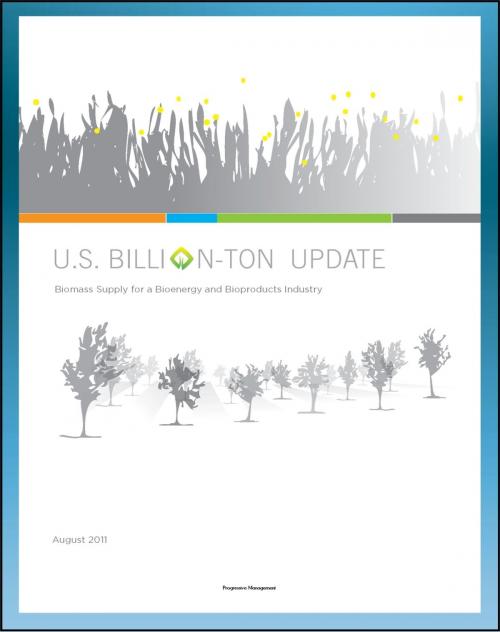U.S. Billion-Ton Update: Biomass Supply for a Bioenergy and Bioproducts Industry - Comprehensive Survey of All Sources of Biomass Energy, Energy Crops, Forest Biomass, Wood Waste, Agricultural Waste
Nonfiction, Science & Nature, Science, Physics, Energy, Technology, Agriculture & Animal Husbandry| Author: | Progressive Management | ISBN: | 9781465767158 |
| Publisher: | Progressive Management | Publication: | March 9, 2012 |
| Imprint: | Smashwords Edition | Language: | English |
| Author: | Progressive Management |
| ISBN: | 9781465767158 |
| Publisher: | Progressive Management |
| Publication: | March 9, 2012 |
| Imprint: | Smashwords Edition |
| Language: | English |
This important report on the feasibility of a billion-ton annual supply of biomass for bioenergy and bioproducts, updated for 2011, has been converted for accurate flowing-text ebook format reproduction.
Contents: Introduction * Biomass In Current and Projected Energy Consumption * Forest Biomass and 13 Wood Waste Resources * Agricultural Biomass and Waste Resources * Biomass Energy Crops * Summary
The purpose of this report is to update the 2005 Billion-ton Study (BTS) and change its focus from a strategic assessment to a comprehensive resource assessment, thereby addressing issues raised since its publication. One major criticism of the 2005 BTS was that the identified potential biomass was not restricted by price, and some of the potential feedstocks would likely be too expensive relative to other feedstocks under current and prospective technological change (i.e., not be economically available). This update provides estimates of prices and quantities of the resource potential (i.e., supply curves). This update also treats sustainability much more rigorously, and it focuses on currently unused resources and energy crops. Full analysis of the sustainability of large-scale biomass production is not the intention of this report; however, quantitative projections presented may be useful for further analyses of the environmental and social aspects of using biomass for energy.
The original report included biomass that was currently being used for energy production because it counted toward the billion-ton goal. In this update, currently consumed biomass resources, such as wood residues and pulping liquors used in the production of forest products, are treated separately to avoid confusion with the unused potential. The update focuses on deriving estimates of biomass available for additional energy production and bioproducts at different prices and locations across the continental United States.
Chapter 2 provides a summary of biomass resources currently used in the production of biofuels, heat, and power. This chapter also provides projections of currently used biomass to the year 2030. Chapter 3 assesses forest biomass and waste resources. Agricultural resources are evaluated in two chapters. Chapter 4 assesses primary crop residues from the major grains, as well as other crop residues, crop processing residues, and animal manures. These latter resources were listed in the 2005 BTS as other crop residues and other residues. Chapter 5 contains the assessment of the energy crops and includes perennial grasses, woody crops, and annual energy crops. Chapter 6 provides a summary of the resource assessment update. For convenience and ease in reading, a decision was made to show feedstock quantities and their composite total at the $60 per dry ton level in many of the figures and tables in the report. This price was selected because it brings in most of the available tons from all of the feedstocks and because the price represents a realistic, reasonable price for discussion purposes.
This important report on the feasibility of a billion-ton annual supply of biomass for bioenergy and bioproducts, updated for 2011, has been converted for accurate flowing-text ebook format reproduction.
Contents: Introduction * Biomass In Current and Projected Energy Consumption * Forest Biomass and 13 Wood Waste Resources * Agricultural Biomass and Waste Resources * Biomass Energy Crops * Summary
The purpose of this report is to update the 2005 Billion-ton Study (BTS) and change its focus from a strategic assessment to a comprehensive resource assessment, thereby addressing issues raised since its publication. One major criticism of the 2005 BTS was that the identified potential biomass was not restricted by price, and some of the potential feedstocks would likely be too expensive relative to other feedstocks under current and prospective technological change (i.e., not be economically available). This update provides estimates of prices and quantities of the resource potential (i.e., supply curves). This update also treats sustainability much more rigorously, and it focuses on currently unused resources and energy crops. Full analysis of the sustainability of large-scale biomass production is not the intention of this report; however, quantitative projections presented may be useful for further analyses of the environmental and social aspects of using biomass for energy.
The original report included biomass that was currently being used for energy production because it counted toward the billion-ton goal. In this update, currently consumed biomass resources, such as wood residues and pulping liquors used in the production of forest products, are treated separately to avoid confusion with the unused potential. The update focuses on deriving estimates of biomass available for additional energy production and bioproducts at different prices and locations across the continental United States.
Chapter 2 provides a summary of biomass resources currently used in the production of biofuels, heat, and power. This chapter also provides projections of currently used biomass to the year 2030. Chapter 3 assesses forest biomass and waste resources. Agricultural resources are evaluated in two chapters. Chapter 4 assesses primary crop residues from the major grains, as well as other crop residues, crop processing residues, and animal manures. These latter resources were listed in the 2005 BTS as other crop residues and other residues. Chapter 5 contains the assessment of the energy crops and includes perennial grasses, woody crops, and annual energy crops. Chapter 6 provides a summary of the resource assessment update. For convenience and ease in reading, a decision was made to show feedstock quantities and their composite total at the $60 per dry ton level in many of the figures and tables in the report. This price was selected because it brings in most of the available tons from all of the feedstocks and because the price represents a realistic, reasonable price for discussion purposes.















